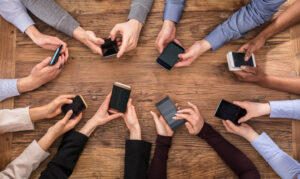
Sensory Memory: The Motor Behind Your Hidden Abilities
Can you see with your eyes closed? Can you hear someone’s voice, even when you’re alone? Have you ever traveled in time with a smell that reminds you of a certain place? These are just some of the amazing powers of our sensory memory, which uses all five of our senses to capture and remember the world. Find out what sensory memory is, the different types of sensory memory, and how to improve it.

“…taste and smell alone, more fragile but more enduring, more unsubstantial, more persistent, more faithful, remain poised a long time, like souls, remembering, waiting, hoping, amid the ruins of all the rest…” -Marcel Proust
What is sensory memory?
We have the unlimited ability to perceive, register, and store information about our environments, and sensory memory is what makes it possible. Our senses perceive and capture information about objects and ideas around us. The sensory memory system makes the exterior information that we perceive “last” longer, which makes it possible to be captured and understood by other memory systems.
The sensory information that we retain doesn’t only make it possible to recognize our environment (smell someone’s perfume and know who it is, recognize a person’s voice, etc.), it also makes it possible to make sense of the future. For example, when you eat a lemon and perceive the taste of the acidity, your body and brain will remember the sensation. Later, when you see a lemon being cut, your mouth will salivate due to the sensory memory of the flavor. We store sensory information that is linked to a degree of attraction or different sensations that are felt in the moment of their “recording”. The same stimulus that one person sees as an unpleasant experience, another may perceive as a pleasant one.
Sensory memory also plays a role in our other memory systems. It quickly and effectively tells the brain which stimuli should be attended to by short-term memory and saves particular parts of the original memory in long-term memory which can be recognized later on.
Types of sensory memory
Our five senses make up the five types of sensory memory. Each one makes it possible to recognize and remember perceived impressions, along with the value that it was given during perception.
1. Auditory or Echoic Sensory Memory
The main function of auditory sensory memory is to capture sounds and auditory experiences in order to prolong its presence and be captured by other response systems. This type of memory can prolong the presence of a sound for up to 10 seconds after it has ended.
You may find that sometimes you ask someone to repeat what they’ve said, but after they’ve started, you realize that you actually heard them the first time. You didn’t know that you were listening, but your ears did their work and captured the auditory information from the environment.
2. Visual or Iconic Sensory Memory
Visual or iconic memory plays an important role when recording visual sensory experiences. Our eyes work like a camera that is constantly taking pictures of our surroundings and makes it possible to make each bit of information last longer so that it can be linked to other images. While this ability to capture visual information from the environment makes the information “last” longer, it does not last quite as long as echoic (auditory) memory. If auditory sensory memory can last up to 10 seconds, iconic sensory memory can last up to a maximum of 250 milliseconds after being captured. This short amount of time keeps the system from being overloaded with information. We sometimes unintentionally store this visual information in superior memory systems accidentally.
Imagine that you’re riding the subway for 40 minutes. During this commute, you sit in front of someone who you seemingly pay no attention to. The next day, you run into the same person in the grocery store and you recognize them. The images that you remember from the subway were processed and sent to other memory systems.
3. Tactile Sensory Memory
Tactile sensory memory makes it possible to record information about the characteristics of the objects that we touch and feel. Bliss, Crane, Manfield, and Townsend (1966) found in their studies that this ability differs in people with congenital blindness, late onset blindness, and people with normal vision. These differences reflect the ability for improvement through the practice of the tactile memory system.
Suppose that you need to get something from your closet, but they lights went out in your room and you’re left in the dark. You’ll probably find that you’re able to recognize a good amount of your clothes just by touch, without having to see them visually. While you may have never stopped to intentionally take in this kind of information, your sense of touch did its work and processed the information correctly.
4. Olfactory Sensory Memory
Olfactory sensory memory records information about the smells that different stimuli emit. We have the ability to smell and distinguish between a large number of different scents that arrive at our senses every day. In fact, our olfactory skills are able to detect a wider variety of stimuli than any other sense. We are able to link smells to different stimuli and retain this information for quite a long time.
Imagine that you have dinner at your house with a few friends. The next day, you find a jacket in the hallway that someone must have left. You don’t know whose it is because they took the jacket off before coming in the house so you didn’t see anyone wearing it. Smelling the jacket is one of the best ways to figure out whose it is. It’s possible that although you didn’t realize it at the time, you were subconsciously smelling everyone at the dinner all night so you might recognize whose it is.
5. Gustatory Sensory Memory
Gustatory sensory memory captures flavors and later classifies then and retains them as a memory. The sensations that we experience the first few times that we receive a gustatory stimulus are remembered quite strongly. Gustatory sensory memory, like olfactory memory, tends to create strong ties to feelings and reception of stimuli and keep them in a lasting way. Often, eating a certain food will bring you back to another time or situation. Like tactile memory, gustatory memory also requires quite a bit of practice.
Imagine that you go to live in a different country for a while and get used to a certain type of food. After returning to your home country, you try the same food a few years later and find that you’re transported back to the old country with memories that may not have anything to do with the food itself.

How can you improve your sensory memory?
Some people have excellent sensory skills that make it easy for them to perceive and distinguish between stimuli with their skills (or one sense in particular). However, anyone can improve their different types of memory and sensory skills by properly training them. If you are able to develop your senses, you will also be able to improve memory.
Before starting to train and improve your different senses, it’s important to know which are stronger and which are weaker. People with sensory deficits usually compensate their necessities by improving another skill.
Once you have a better idea about each of your sensory memory skills, you’ll know how to best combine them. Imagine that a friend bought a book that you’re interested in reading. You ask them the name of the book and go straight to the bookstore to buy it, but you forget it on the way. However, if you ask the name of the book and look at the cover, noticing what it looks like and the picture it has, you’ll have more sensory data available, thus having a better possibility of remembering the book when you go to the bookstore.
Lastly, in order to complete sensory memory processes, it’s important to develop attention. There are programs available that make it possible to take an online cognitive assessment to help you better understand if your attention and memory processes are working adequately. CogniFit is a professional tool that can help carefully measure attention and other cognitive processes. The program makes it possible to find out your cognitive score with different brain games and activities. CogniFit uses advanced algorithms to find out each user’s cognitive profile and adapt to each person’s cognitive needs. The tasks assigned to the user will be adjusted to their specific needs.
Poor attention affects perception, and without perception, there is no memory. We said earlier that our senses capture information subconsciously, but that’s not always the case. Many people with poor attention also have a poor memory. This is not usually a big problem and is usually caused by missing steps when a memory is perceived. It’s not the same to see passively or watch something, and hearing and listening are two different activities. Being intentional in your actions makes it possible to better manage your memory.
This article was originally written in Spanish and translated into English
References
Bliss, J. C., Crane, H. D., Mansfield, P. K., & Townsend, J. T. (1966). Information available in brief tactile presentations. Attention, Perception, & Psychophysics, 1(4), 273-283.












